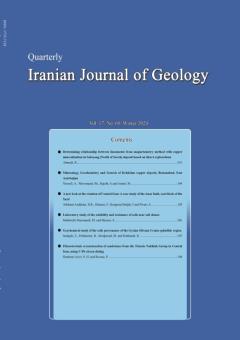Laboratory study of the solubility and resistance of soils near salt domes
Subject Areas :Meisam Mahboubi Niazmandi 1 , Sohrab Mirassi 2
1 - University Lecturer, Faculty of Civil Engineering, Mehraeen Institute of Higher Education, Gilan, Iran
2 - Assistant Professor, Department of Civil Engineering, Shahrekord Branch, Islamic Azad University, Shahrekord, Iran
Keywords: Dissolution Susceptibility, Saline Soils, Salt Domes, Hormuz Island, Soil Resistance.,
Abstract :
One of the most important potential sources of salinity in southern Iran is the dissolution of salt domes, which in most cases leads to the deterioration of the quality of surface waters, karstic aquifers, and adjacent alluvial aquifers. Although karstic and alluvial waters generally have good quality, in many cases in the south of the country, the quality of these waters has decreased due to contact with salt domes. This issue is particularly important in areas such as the lands located on the coasts of the Persian Gulf, where the groundwater level is high. Given that some areas of Hormozgan province, such as Hormuz Island, are composed of salt-susceptible soils with a high percentage of sulfate and gypsum, the occurrence of problems such as subsidence, deviation, and high susceptibility to dissolution is likely. Therefore, this article focuses on examining and evaluating the determination of the susceptibility to dissolution and the resistance characteristics of soils in the areas adjacent to the salt domes on Hormuz Island. The determination of resistance characteristics and susceptibility to dissolution has been carried out based on the results of physical, chemical, technical, and mechanical tests using boreholes and sampling. Some of these characteristics include soil classification, soil moisture content, salt percentage, chloride and phosphate content, maximum density percentage, friction angle, soil cohesion, elasticity modulus, and soil compaction index. The results showed that the presence of salt has led to a decrease in resistance parameters (internal friction angle and cohesion) of the soil. This reduction in cohesion in salt-containing samples compared to natural soil samples without salt has been more pronounced. In addition, the presence of salt leads to an increase in optimal moisture content and a noticeable decrease in maximum dry density of the highly susceptible dissolution soils compared to natural soil samples. Finally, based on the obtained data and the precise identification of susceptible dissolution soils and consideration for future construction in these areas, proposed solutions for preventing and controlling damage to structures on this type of soil have been presented.
[ ] Mirassi, S. and Rahnema, H., 2020. Deep cavity detection using propagation of seismic waves in homogenous half-space and layered soil media. Asian J Civ Eng, 21, 1431–1441 (2020). https://doi.org/10.1007/s42107-020-00288-2
[ ] Rahnema, H. and Mirasi, S., 2012. Seismic and geotechnical study of land subsidence and vulnerability of rural buildings. International Journal of Geosciences, 3(04), p.878.
[ ] Rahnema, H. and Mirassi, S., 2014. Crisis management concerning underground water falling and land subsidence occurrence in the plains of Iran. Advances in Environmental Biology, pp.1453-1466.


